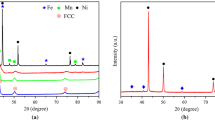Abstract
The fretting wear behaviors and mechanism of a high Nb–TiAl alloy with full lamellar microstructure at ambient temperature were investigated. The fretting wear mechanism of the alloy under different loads and displacement amplitudes was revealed using experiments and molecular dynamics simulations. The results showed that the load and displacement amplitude significantly affected fretting wear behaviors and the mechanism of the Ti–45Al–9Nb alloy. Higher load and lower displacement amplitude could effectively reduce the fretting wear of the alloy. Molecular dynamics simulation results showed that the order-twin lamellar interface hindered the deformation and dislocation movement of twins, improved the mechanical properties of the material, and improved the wear resistance of such alloy. The wear mechanism of Ti–45Al–9Nb alloy was adhesive wear and surface fatigue wear.















Similar content being viewed by others
References
Zhang WJ, Deevi SC, Chen GL (2002) On the origin of superior high strength of Ti–45Al–10Nb alloys-ScienceDirect. Intermetallics 10(5):403–406. https://doi.org/10.1016/S0966-9795(02)00008-0
Lin JP, Xu XJ, Wang YL, He SF, Zhang Y, Song XP, Chen GL (2007) High-temperature deformation behaviors of a high Nb containing TiAl alloy. Intermetallics 15(5–6):668–674. https://doi.org/10.1016/j.intermet.2006.10.029
Lemoine E, Nélias D, Thouverez F, Vincent C (2020) Influence of fretting wear on bladed disks dynamic analysis. Tribol Int 145:106148. https://doi.org/10.1016/j.triboint.2019.106148
Kumar D, Syed N, Akhtar KA, Balani K (2015) Tribological performance of laser peened Ti–6Al–4V. Wear 322:203–217. https://doi.org/10.1016/j.wear.2014.11.016
Park C, Kim J, Sim A, Sohn H, Chun EJ (2019) Influence of diode laser heat treatment and wear conditions on the fretting wear behavior of a mold steel. Wear. https://doi.org/10.1016/j.wear.2019.202961
Sung IH, Kim JW, Noh HJ, Jang H (2016) Effect of displacement and humidity on contact resistance of copper electrical contacts. Tribol Int 95:256–261. https://doi.org/10.1016/j.triboint.2015.11.027
Lee BW, Suh J, Lee H, Kim T (2011) Investigations on fretting fatigue in aircraft engine compressor blade–scienceDirect. Eng Fail Anal 18(7):1900–1908. https://doi.org/10.1016/j.engfailanal.2011.07.021
Kazuhisa M, Bradley AL, Susan LD (2003) Fretting wear of Ti-48Al-2Cr-2Nb. Tribol Int 36:145–153. https://doi.org/10.1016/S0301-679X(02)00142-1
Hager CH, Sanders JH, Sharma S (2004) Characterization of mixed and gross slip fretting wear regimes in Ti6Al4V interfaces at room temperature. Wear 257(1):167–180. https://doi.org/10.1016/j.wear.2003.10.023
Wu GQ, Liu XL, Li HH, Sha W, Huang LJ (2015) Effect of contact pressure on fretting fatigue behavior of Ti-1023. Wear 326–327:20–27. https://doi.org/10.1016/j.wear.2014.12.033
Yang Q, Zhou WL, Gai PT, Zhang XH, Fu XS, Chen GQ, Li ZQ (2017) Investigation on the fretting fatigue behaviors of Ti–6Al–4V dovetail joint specimens treated with shot-peening. Wear 372–373:81–90. https://doi.org/10.1016/j.wear.2016.12.004
Alhafez IA, Urbassek HM (2016) Scratching of hcp metals: a molecular-dynamics study. Comput Mater Sci 113:187–197. https://doi.org/10.1016/j.commatsci.2015.11.038
Chen K, Wang LB, Chen YT, Wang QW (2017) Molecular dynamics simulation of interfaces and microstructure evolution during high-speed sliding. Numer Heat Trans; Part A: Appl, 72(7):1–17. https://doi.org/10.1080/10407782.2017.1386513
Luan B, Robbins MO (2005) The breakdown of continuum models for mechanical contacts. Nature 435(7044):929–932. https://doi.org/10.1038/nature03700
Jeng YR, Tsai PC, Fang TH (2005) Molecular dynamics studies of atomic-scale tribological characteristics for different sliding systems. Tribol Lett 18(3):315–330. https://doi.org/10.1007/s11249-004-2758-3
Kusano Y, Hutchings I M (2003) Modelling the entrainment and motion of particles in a gap: application to abrasive wear. ARCHIVE Proc Inst Mech Eng Part J J Eng Tribol 1994–1996 (vols 208–210), 217(6): 427–433. https://doi.org/10.1243/135065003322620255
Wen DS, Kong BB, Wang SR, Zhang MY (2021) Atomic-scale investigation on fretting wear mechanism of γ phase in a cast Ti-45Al alloy. Appl Surf Sci 565(2):150555. https://doi.org/10.1016/j.apsusc.2021.150555
Inui H, Nakamura A, Oh MH, Yamaguchi M (1991) High-resolution electron microscope study of lamellar boundaries in Ti-rich TiAl polysynthetically twinned crystals. Ultramicroscopy 39(1–4):268–278. https://doi.org/10.1016/0304-3991(91)90206-L
Inui H, Oh MH, Nakamura A, Yamaguchi M (1992) Ordered domains in TiAl coexisting with Ti3Al in the lamellar structure of Ti-rich TiAl compounds. Philos Mag A 66(4):539–555. https://doi.org/10.1080/0141861920820157
Brotzu A, Felli F, Marra F, Pilone D, Pulci G (2018) Mechanical properties of a TiAl-based alloy at room and high temperatures. Mater Sci Technol 65:1–7. https://doi.org/10.1080/02670836.2018.1491931
Vingsbo O, Söderberg S (1988) On fretting maps. Wear 126(2):131–147. https://doi.org/10.1016/0043-1648(88)90134-2
Zhou ZR, Fayeulle S, Vincent L (1992) Cracking behavior of various aluminum alloys during fretting wear. Wear 155(2): 317–330. https://doi.org/10.1016/0043-1648(92)90091-L
Zhou ZR, Nakazawa K, Zhu MH, Maruyama N, Kapas P, Vincent L (2006) Progress in fretting maps. Tribol Int 39(10):1068–1073. https://doi.org/10.1016/j.triboint.2006.02.001
Zhu MH, Zhou ZR, Kapsa P, Vincent L (2001) An experimental investigation on composite fretting mode. Tribol Int 34(11):733–738. https://doi.org/10.1016/S0301-679X(01)00061-5
Zhou ZR, Vincent L (1997) Cracking Induced by Fretting of Aluminium Alloys. J Tribol 119(1): 36–42. https://doi.org/10.1115/1.2832477
Liu HW, Xu XJ, Zhu MH, Ren PD, Zhou ZR (2011) High-temperature fretting wear behavior of WC–25Co coatings prepared by D-gun spraying on Ti–Al–Zr titanium alloy. Tribol Int 44(11):1461–1470. https://doi.org/10.1016/j.triboint.2011.01.002
Zhou ZR, Vincent L (1995) Mixed fretting regime. Wear 181–183:531–536. https://doi.org/10.1016/0043-1648(95)90168-X
Hu RH, Lim JK (2010) Hardness and wear resistance improvement of surface composite layer on Ti–6Al–4V substrate fabricated by powder sintering. Mater Des 31(5):2670–2675. https://doi.org/10.1016/j.matdes.2009.11.057
Mindlin RD (1949) Compliance of elatsic bodies in contact. J Appl Mech 16:259–268. https://doi.org/10.1007/978-1-4613-8865-4_24
Wang JG, Zhang LC, Chen GL, Ye HQ (1998) TEM observations of mechanical twins in a hot-deformed Ti–45Al–10Nb alloy. Mater Sci Eng, A 252(2):222–231. https://doi.org/10.1016/S0921-5093(98)00673-X
Acknowledgements
This work was supported by the National Natural Science Foundation of China (51705199 and 51872122), the Key Technology Research and Development Program of Shandong (2019GGX104045).
Author information
Authors and Affiliations
Corresponding author
Ethics declarations
Conflict of interest
The authors declare that they have no conflict of interest.
Additional information
Handling Editor: Megumi Kawasaki.
Publisher's Note
Springer Nature remains neutral with regard to jurisdictional claims in published maps and institutional affiliations.
Rights and permissions
Springer Nature or its licensor holds exclusive rights to this article under a publishing agreement with the author(s) or other rightsholder(s); author self-archiving of the accepted manuscript version of this article is solely governed by the terms of such publishing agreement and applicable law.
About this article
Cite this article
Song, Q., Liu, L., Wen, D. et al. Fretting wear behaviors and mechanism of a high Nb–TiAl alloy with full lamellar microstructure at ambient temperature. J Mater Sci 57, 15636–15650 (2022). https://doi.org/10.1007/s10853-022-07605-x
Received:
Accepted:
Published:
Issue Date:
DOI: https://doi.org/10.1007/s10853-022-07605-x




